Jeanne Paquin: Couturière of the Modern World—Fashion, Feminism, and Ocean Elegance
📌 Explore the global legacy of Jeanne Paquin, the pioneering Parisian designer whose fashion empire dressed women across oceans. From daily dress reviews to transatlantic couture, Paquin's elegant, wearable designs remain an inspiration for students, historians, and genealogists alike.

Mme. Paquin Is a Brilliant Figure in the Woman's Movement of 1913, for It Is Seldom That Such Tremendous Business Success Is Coupled With So Much Youth, Beauty, and Generosity. Mme. Paquin's Philanthropies Are Famous. (The Delineator, January 1913) | GGA Image ID # 1cb58c2388
👑 Paquin: The Fashion Empress Who Dressed the World—From Paris to the Promenade Deck
Mme. Jeanne Paquin (1869–1936), known as “The Czarina of Dress,” built one of the most powerful and influential fashion houses of the Belle Époque and early 20th century. Her career fused innovation, business acumen, artistic flair, and a groundbreaking approach to customer experience—all while becoming a role model for ambitious women across the globe.
For educators and students, the House of Paquin offers a perfect lens into:
- The emergence of modern fashion marketing
- The evolution of women’s public identity through dress
- Cross-continental fashion exchange, especially for transatlantic travelers and elites
- Genealogical clues about dress customs, millinery, or tailoring found in family photos or passenger lists
Jeanne Paquin—an icon of haute couture and a defining figure in the evolution of fashion as it intersected with women’s independence, social mobility, and transatlantic travel. This resource-rich page is crafted for teachers, students, genealogists, and fashion historians, with relevant visual highlights, terminology, and educational insights. 🎓👒🛳️
Mme. Jeanne Paquin (1869–1936), the famous Parisian couturière, is a name that resonates with the American public. As one of the few women dressmakers of note in Paris, her work has not only been brilliantly successful but also a source of hope and motivation for other women. Her career, built on hard work, deep study, and outstanding native ability, has the power to stimulate and inspire women, regardless of their profession, to strive for their dreams.
The Czarina of Dress
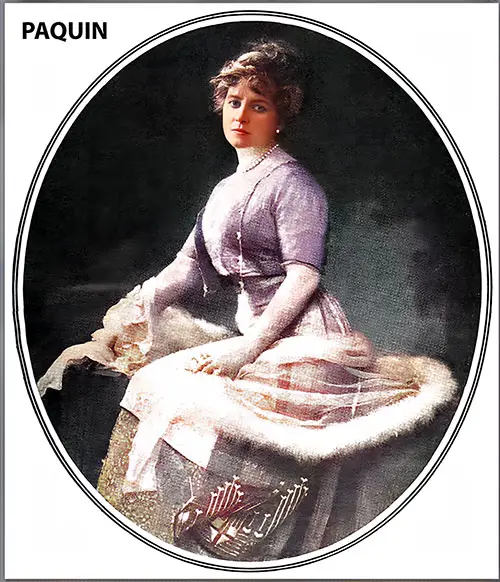
Madame Paquin of the House of Paquin. (The Cosmopolitan, March 1911) | GGA Image ID # 1cd59c6083
"PAQUIN!" When you hear that, it conveys an idea.
Those who worship at the shrine of fashion and bow to the dictates of the autocrat of dress speak and bow reverentially. Those who drive against the cutting edge of competition may say a bit disparagingly. Throughout the Continent, they speak of the House of Paquin in various tones.
The Paquin—whether "Monsieur" or "Madame"—was mentioned as "the genius of the Rue de la Paix." She is a monarch whose empire is bounded only by those boundaries that compass the universe. When Monsieur Paquin died in December 1907, Madame Paquin entered the limelight to which she had been manifestly entitled. Her dressmaking establishment is now called the House of Paquin.
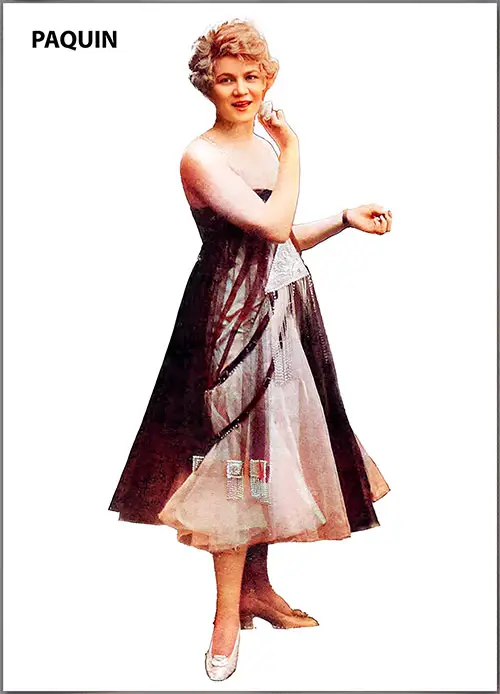
Paquin Has Also Recently Made a Charming Evening Gown of Black Tulle Over Which Broad Black Velvet Ribbons Fall In Straight Lines. There Are Three Thicknesses of Tulle, and Over These Is Draped a White Valenciennes Flounce Tied Low at the Knee on Each Side and Half Hidden Beneath a Deep Ruffle of Black Chantilly Lace. The Bodice, Partly Clouded in Chantilly Lace, Has the Valenciennes Passing Straight Across the Corsage and Knotting About Each Arm. A Bunch of Crimson Roses Lends a Touch of Color in Front. (Harper's Bazar, July 1916) | GGA Image ID # 1cd5a133d4
Paquin revolutionized the fashion show experience with her innovative concept of the 'audience room.' This was a dedicated space within her store where she would showcase her latest designs. To bring these designs to life, she employed the most beautiful models that money could secure.
Those who sought fashion experience have probably witnessed the parades of the Paquin models in the Paris store. These parades, known as 'the daily dress reviews,' were a spectacle to behold. Madame Paquin carried them on with only the intermissions that dull seasons demand.
The House of Paquin, with its dual presence in Paris and London, stands as a beacon of fashion. It is a Mecca, drawing in thousands and tens of thousands of women from across the globe-from America, Europe, Australia, and Asia-who make their annual pilgrimage to witness its influence firsthand.

A Dress of Steel Lace Covered With Narrow Tulle Was Made by Madame Paquin for Mademoiselle Céliat. The Corsage Is Nothing More Than a Wide Girdle of Blue Moire and Steel Tulle Folding Over the Shoulders. (Harper's Bazar, August 1916) | GGA Image ID # 1cd5a71478
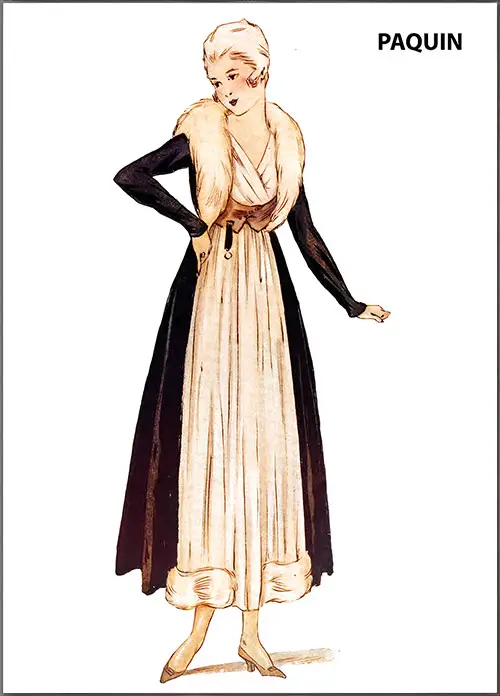
The House of Paquin Took a Simpler Note Than Many Others and, With Characteristic Conservatism, Showed a Decided Preference for Tulle Over Silver Tissue for Evening and Dance Gowns. Generally Speaking, Such Gowns Were Demure Rather Than Sophisticated and Trimmed Profusely With Silver Lace. For the Ubiquitous Princess Dress of Wool or Velvet, Paquin Approved of Plaits Rather Than Shirring. (Harper's Bazar, October 1916) | GGA Image ID # 1cd5e9569f

Striking in Its Beautiful Simplicity Is a Paquin Gown, Made of Plain, Dull Blue Mousseline de Soie. The Full Tunic Drops a Slender Pointed Train, and the Edges of It Are Bound With Satin of a Darker Shade; Into the Folded Belt of the Darker Blue Is Thrust a Rose of Coral Pink Silk. The Wrap Designed Primarily To Be Worn With This Gown Is Made of Blue Crêpe de Chine, Heavily Embroidered in Dull Persian Colors. The Wide Double Ruffles That Trim It Are the Material of the Gown. (Harper's Bazar, May 1913) | GGA Image ID # 1cbadb2f14
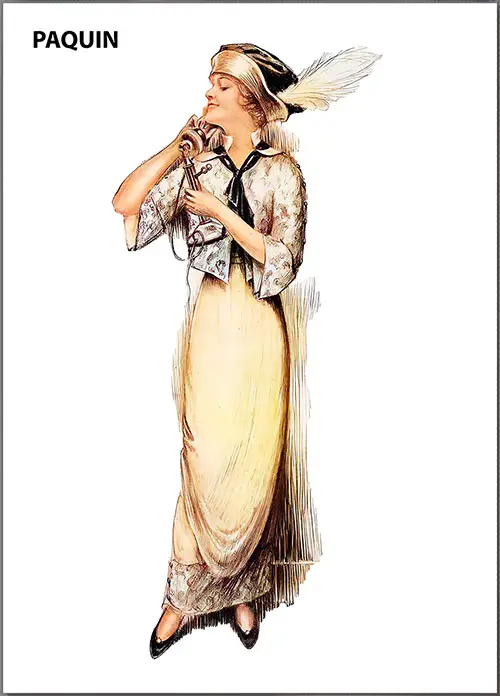
A White Louisine Silk Dress Has a Hem and a Little Jacket of Coarsely Woven Cotton Printed in Colors. A green Silk Collar and Scarf Add a Brilliant Bit of Color. Taffeta Silks in Changing Invisible Checks In Light Colors Are Made Into Novel Wraps and Loose Long Coats for Evening Wear, and Long and Short Lace Coats Are Worn With Gowns to Match or As Separate Garments. All a Fluff With Frills and Ribbon Ends, They Are Lined Only With One Thickness of Mousseline de Soie. (Harper's Bazar, May 1913) | GGA Image ID # 217f23a675
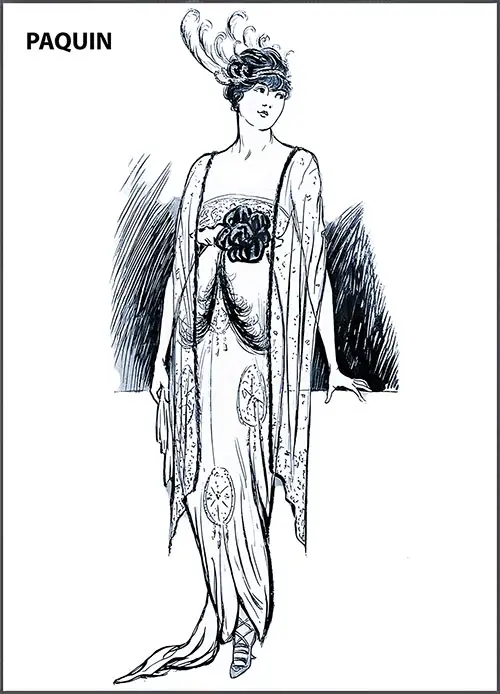
Over the Foundation of Pale Blue Satin With Pearl, Embroidered Disks Hangs a Beaded Scarf, Forming the Sleeves and Attached to a Flesh-colored Lining. Two Black Paradis Are Arranged in the Front, and a Narrow Fur Edge Outlines the Scarf. The Headdress Is One of Paquin's Newest Designs and Shows a Band and Scroll of Rhinestones With Black and White Paradis. (Harper's Bazar, October 1913) | GGA Image ID # 1cbadf7a2f
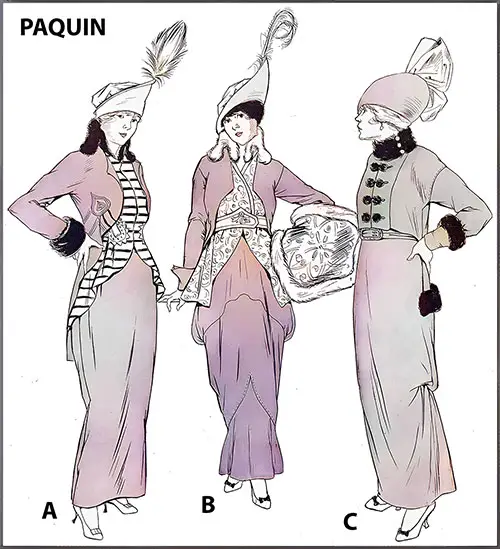
New Street Costumes from Paquin. Drawings by Tighe. (Harper's Bazar, November 1913) | GGA Image ID # 1cbb1967bf
(A) Paquin's coats are unique, and one of the smartest is the long-tailed cutaway in mauve velours de Laine opening over a single-breasted waistcoat of mauve and yellow striped satin. The waistcoat is as unusual as the coat; it is closed to the waistline and flares out in full godet plaits at the sides. The line of the motifs of passementerie on the waistcoat is continued by stitching on the coat. Beaver cuffs and collars add the requisite touch of fur.
(B) Curiously shaped tunics distinguish the skirt of the dressy black velvet afternoon costume. The upper tunic is full, with the fulness drawn toward the sides and the back. There is a slight fullness in the lower tunic, which is attached by stitching to the lower part of the skirt. The waistcoat of blue and gold velours delaine extends over the hips in tunic fashion, the godet plaits lending the flare. The muff of the velours de Laine is edged with bands of the gray fox, matching the high-standing collar.
(C) Paquin contrasts material and color in one of her most striking costumes. The skirt is of golden-brown velvet, with the drapery caught at the side, and the dashing little jacket is of white ratine. This jacket is very short in front, showing the girdle and handsome jeweled buckle and fastening directly down the center with skunk fur buttons. A collar of the fur fastens snugly to the neck by small buttons. Bands of fur edge the long tails of the coat and finish the top of the cuffs.
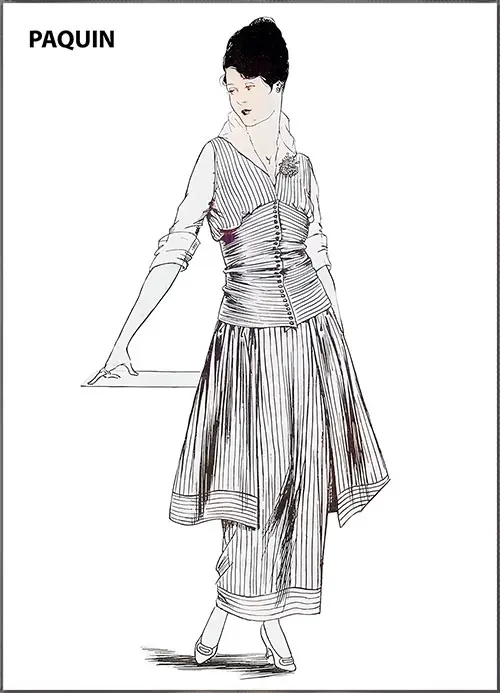
Paquin Designed Geraldine Farrar's Summer Frock. A Curious High Girdle, Buttoning Down the Back and the Front, Makes This Blue and White Striped Taffeta Frock Particularly Becoming. There Is the Long Tunic Finished With a Band in Which the Stripes Run Transversely, and the Simple Bloused Corsage Is Worn Over a Lingerie Guimpe. (Harper's Bazar, August 1914) | GGA Image ID # 1cbb2c7c29
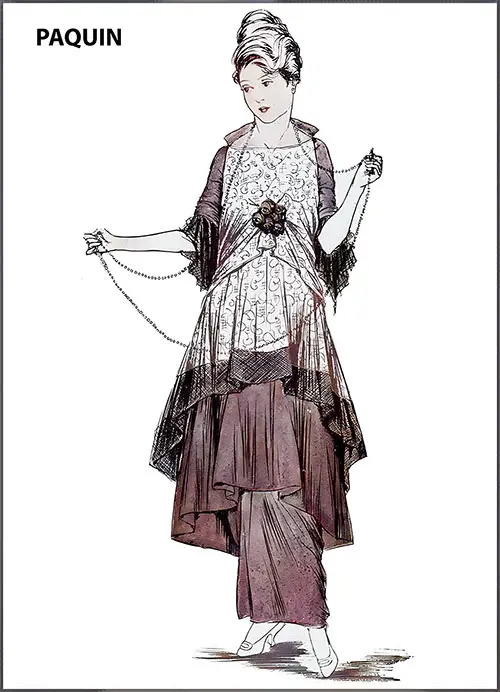
On the Black Taffeta Gown by Paquin, There Is a Touch of Nattier Blue Taffeta in the Upstanding Plaited Ruche at the Neck and in the Girdle. Over the Tunic, Which Stands Out in Handkerchief Points, Falls a Tunic of Cream Filet Lace Matching the Rounded Berthe, Which Veils the Entire Bodice. (Harper's Bazar, August 1914) | GGA Image ID # 1cbb4f46ce
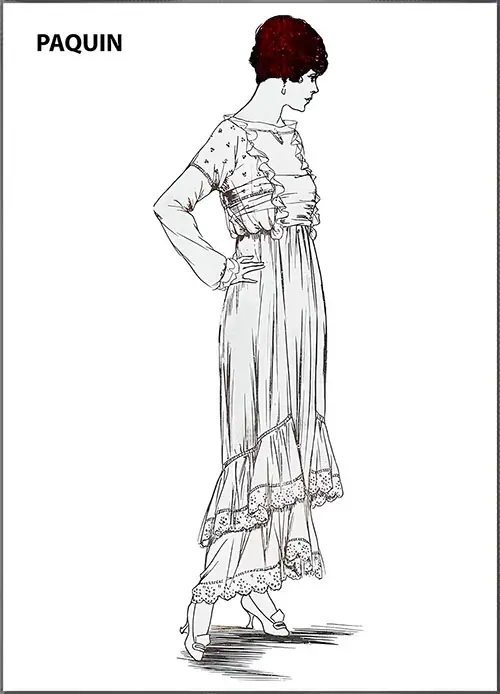
Deliciously Fluffy and Summery Is the Lingerie Net Frock Displaying an Odd Use of Embroidered Batiste Edging, Which Appears as an Outline to the Ruffles of Net on the Skirt, on the Sleeves, and Around the Neck. At the Same Time, a High Plastron of Heavy White Taffeta Fills in the Front. (Harper's Bazar, August 1914) | GGA Image ID # 1cbbcb3e81
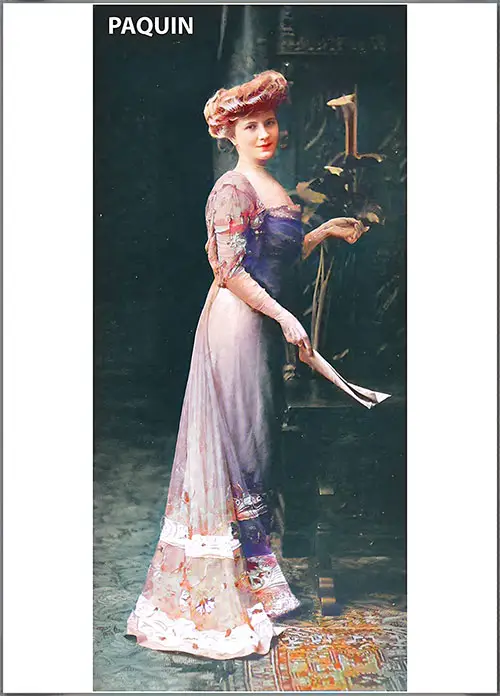
Evening Dress by Paquin. Photo by Boissonnas et Taponier. (Les Modes, September 1908) | GGA Image ID # 1cb4a9e43d
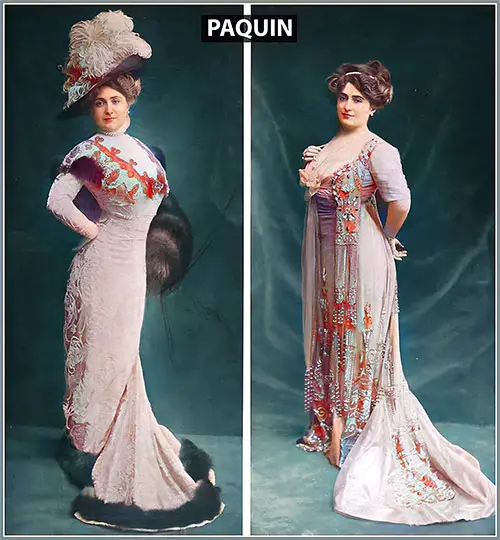
Mlle Marguerite Labady Wearing Fashions from Paquin. (l) After Midday Dress. (r) Evening Dress. (Les Modes, September 1908) | GGA Image ID # 1cb54df0a0
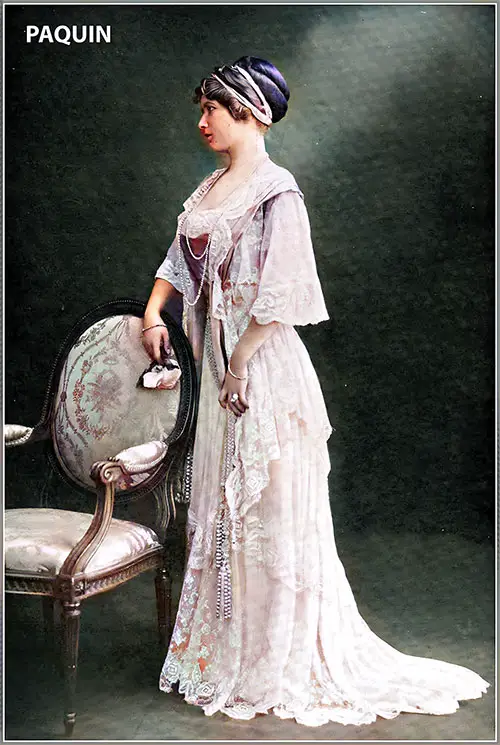
Interior (House) Dress by Paquin. Photo by Reutling. (Les Modes, September 1908) | GGA Image ID # 1cb587d961

Mlle Berthe Bady Wearing an Afternoon Gown by Paquin. Photo by Félix. (Les Modes, Issue 112, April 1910) | GGA Image ID # 1ce21128b1
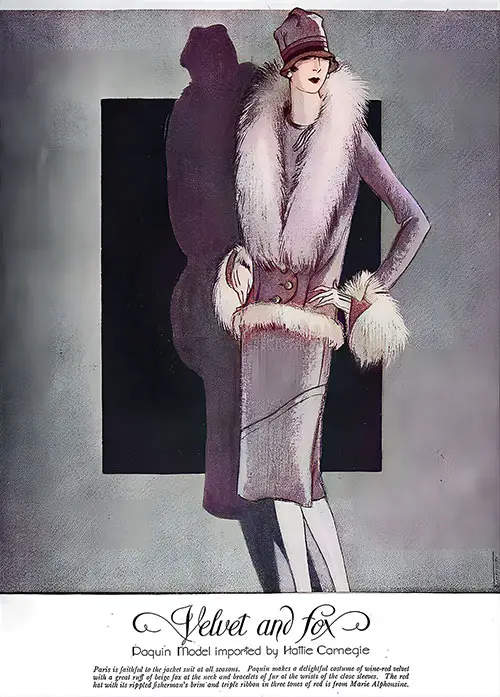
Velvet and Fox, A Paquin Model Imported by Hattie Carnegie. Paris is faithful to the jacket suit at all seasons. Paquin makes a delightful wine-red velvet costume with a great ruff of beige fox at the neck and fur bracelets at the wrists of the closed sleeves. Marie Alphonsine made the red hat with its rippled fisherman's brim and triple ribbon in three tones of red. (The Delineator, December 1926) | GGA Image ID # 2182355857
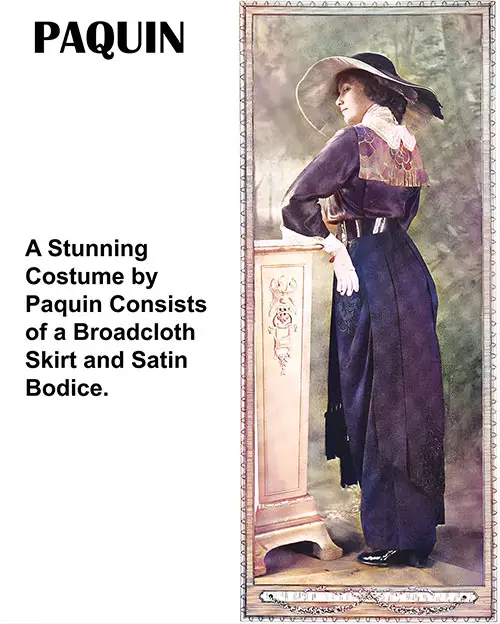
A Stunning Costume by Paquin Consists of a Broadcloth Skirt and Satin Bodice. (Dry Goods Economist, 22 June 1912) | GGA Image ID # 2255f71f67
The History of the House of Paquin
Beginning in the 1890s and continuing down to the period of the World War, the House of Paquin was the leading couture establishment in Paris. M. Isador Paquin began his business life as an obscure clerk in the Paris Bourse. In Paris, Madame Paquin is looked upon as one of the cleverest and most fertile of the French designers.
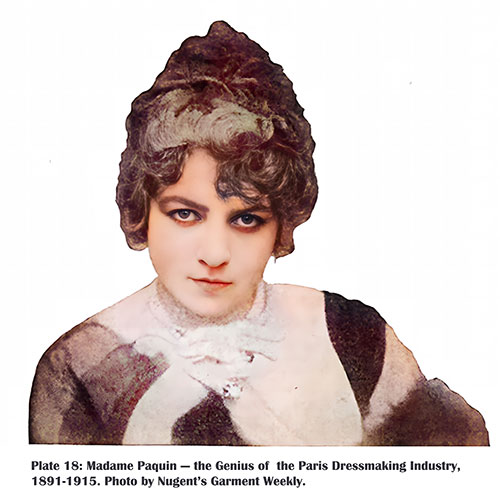
Plate 18. Madame Paquin—the Genius of the Paris Dressmaking Industry, 1891-1915, Photo by Nugent’s Garment Weekly. (Economics of Fashion, 1928) | GGA Image ID # 217f79d6bb
Madame Paquin had been trained in sewing and designing at Rouff's, a well-known couture establishment during the 1870s and 1880s. They were married about 1891 and were shortly afterward set up in business in a good location by a wealthy patron.
Paquin and his gifted wife came nearer to being dictators of fashion than any other creator of styles in the last hundred years. Paquin's early prominence grew out of daring sponsorship of simple, youthful garments, in opposition to the heavy sleeves and bulk of the garments of the 1890s.
The house of Paquin developed and helped to popularize the hobble skirts of 1908-9 and the sheath and Directoire gowns of 1910-12. After M Paquin died in 1907, Mme Paquin continued to be in charge of the business until the period of the World War. The establishment still exists, but the firm's ownership is in English hands under a director named M. Clement.
Paquin's influence in the fashion world extended beyond the production of fine apparel for Parisian social elites. While Worth catered to nobility and aristocracy, Paquin revolutionized fashion by making it accessible to a broader audience of wealthy women previously excluded from mainstream trends.
Paquin pioneered large-scale sales to department stores and wholesalers, a novel business model at the time. They also developed a significant export trade and sold reproduction models, further expanding their reach.
The House of Paquin also demonstrated its foresight by embracing the influence of futuristic art on fashion from 1910 to 1914. They were among the first to incorporate modern art into their designs, as seen in the Russian ballet.
In 1914 and 1915, they commissioned Russian painter Bakst to design gowns, further solidifying their reputation for innovation. The house of Paquin has always been renowned for its use of velvet and satin in evening garments, a testament to their enduring style.
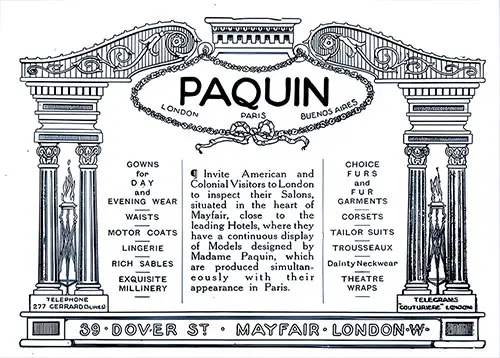
Paquin: London, Paris, Buenos Aires. Invite American and Colonial Visitors to London to Inspect Their Salons, Situated in the Heart of Mayfair, Close to the Leading Hotels, Where They Have a Continuous Display of Models Designed by Madame Paquin, Which Are Produced Simultaneously With Their Appearance in Paris. Gowns for Day and Evening Wear, Waists, Motor Coats, Lingerie, Rich Sables, Exquisite Millinery, Choice Furs and Fur Garments, Corsets, Tailor Suits, Trousseaux, Dainty Neckwear, and Theatre Wraps. Telephone: 277 Cerraro (Lines). Telegrams: “Couturière” London. 39 Dover St. Mayfair, London W. (Cunard Daily Bulletin, Summer Special, 1912) | GGA Image ID # 2244cc5498
London and Paris Fashions: Paquin, June 1906
Indeed, Millinery serves as a unique window into the current fashion landscape. A conversation with Paquin of Dover Street leaves me convinced that Millinery is currently thriving, offering such a diverse range of styles that there's something to complement every face.
A charming trio of hats has been sketched at the Mai son Paquin, indicating some of the modes of the hour. Here, we note that peacock feathers (despite superstition), ostrich plumes, fancy wings, flowers, and ruchings are the favorite trimming for headgear.
The lace hat, a delicate and enchanting choice, is particularly appealing for the young girl. A vision of white lace, adorned with garlands of flowers and tulle, seems to perfectly capture the essence of the month of roses. These days, we're seeing large roses in all shades adorning Millinery, with the rose reigning as the ultimate favorite.
It is useless to lay down definite rules regarding Millinery. For instance, at a house like Paquin's, you will see some curious autumnal flowers, such as chrysanthemums and dahlias, on an essentially June hat, which typically features lighter and more delicate elements. There is no congruity in the mind of the master milliner. Still, there is always good style and a beautiful blending of colors.
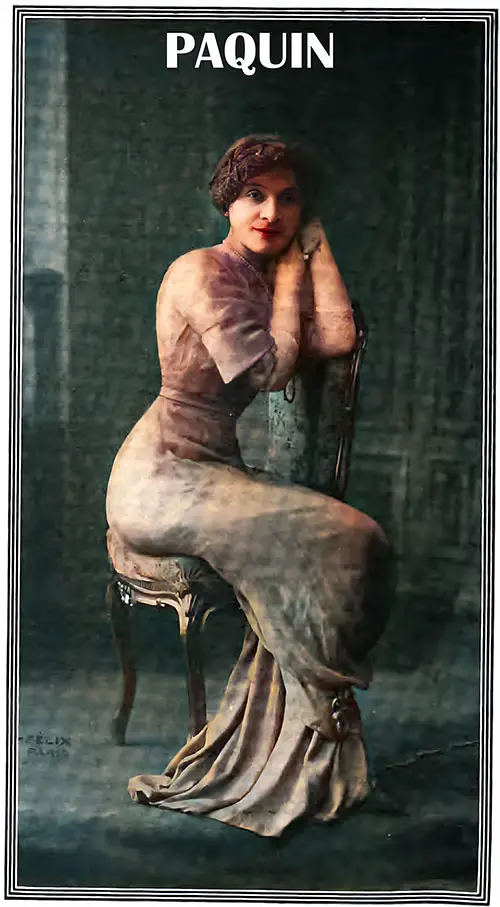
Paquin Designed Silk Gown. Photo by Félix, Paris. (Silk Magazine, March 1910) | GGA Image ID # 224eaba52f
Paquin, Ltd. Women's Fashions – Parisian Modistes
In the realm of dress, the firm Paquin Ltd. stands well to the front as one of the great arbiters of fashion. American ladies do not need to be urged to visit this famous house.
They may not know that visiting Paris to see the latest fashions is unnecessary, as the creations are produced simultaneously in the two cities. At the beautiful Ateliers at 39 Dover Street, London, they will see just the same sartorial results as they would do in Paris, whilst in the realm of millinery, they will find not only the newest and most original designs of this department but those of all the leading houses in Paris.
Here, I have recently vouchsafed glimpses of the present and future modes. I recall a procession of beautiful frocks, all bearing the distinctive "cachet" of the house of Paquin.
The panier was in evidence in the evening gown which passed before me, the bodice and draperies of which were of soft apple-green silk, the latter caught with a bunch of shaded roses to fall at one side of the back over the long-pointed train of the white satin under-dress.
The transparency of the upper part of the décolleté bodice was veiled in heavy guipure lace, and a gathered vest piece of "vieux rose" satin gave a pretty touch of color to the bodice.
My mind's eye also conjures up visions of a white satin gown of Egyptian design, with a swathed chiffon sash; a lovely tea- gown of cream lace over canary yellow satin, the skirt bordered with three widely-spaced tucks, each one edged with a fringe of single beads.
A "visite" of coppery-red taffetas with a shell-like old-world trimming of the silk round the edge and a heavily embroidered écru collar; a smart tailor-made—for which gown Paquin is famous—of navy and white striped serge.
The coat's V-shaped openings were filled in with horizontal arrangements of the stripes, as were those between the wide rounded panels of the back and front of the skirt of an original gown in which taffeta and cloth were allied. The skirt front was of the former, whilst the back of the latter was rounded off from the waist panel-wise.
Last but not least, a charming indoor dress suggests the master touch of M. Paul Iribe. It was composed of a bordered navy foulard dotted with white pin spots. The skirt was finely pleated from hem to waist without interfering with its slim outlines, while a wide jabot of Broderie Richelieu adorned the front of the fashionable coatee-like bodice.
These are but a few of the lovely gowns to be seen at the house of Paquin, 39, Dover Street, where I must not forget to say that special attention is being given to blouses and lingerie and to the unique corset for which the house is so famous.
Furs of the finest quality can be obtained here. The firm is in touch with the leading furriers and dealers worldwide.
Scotch tweeds and hand-woven fabrics have a reputation worldwide, and when it comes to "sports" and traveling garb, a costume or garment fashioned of one or other of the North British fabrics is an absolute necessity, as nothing else possesses the same durability, lightness, and rain-proof quality.
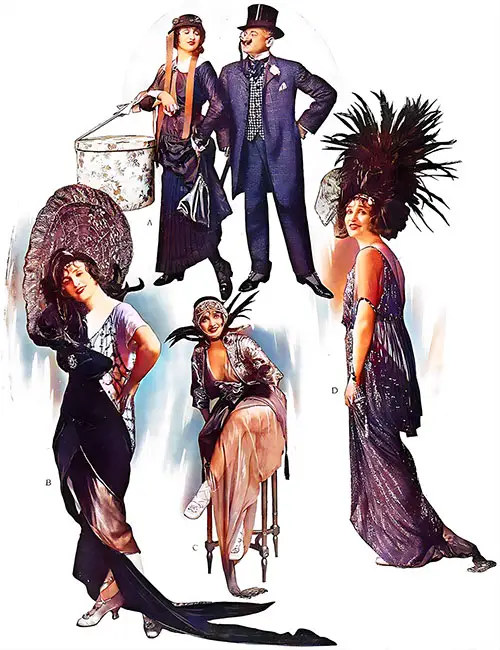
A Tornado of Clothes: Frocks Fashioned by Paquin from Designs by Drian. It is not a question of whether another fair charmer is outshone, but rather of seventy-four winners set aside. Gaby Deslys selects her gowns from a total of seventy-five costumes, all showcasing the latest fashions. In her stunning attire, she captivates the male audience and ignites envy among the women attending "The Belle of Bond Street" at the Shubert Theatre. (Harper's Bazar, May 1914) | GGA Image ID # 224dcfa574. See Additional Captions Below.
A Tornado of Clothes: Frocks Fashioned by Paquin Captions:
A. Gaby Deslys Embodies the Quintessential Midinette, Donning a Stylish, Ruffled Taffeta Creation Complemented by a Plain, Organdy Collar and Cuffs. These Details Add a Playful Touch Rather Than Representing a Badge of Servitude.
B. if Any of the Seventy-Five Gowns Could Be Said to Reflect Gaby Deslys’s Temperament Best, It Would Be the Orange and Black Exotic Creation She Elegantly Twists Around Her Lithe Figure.
C. Light as Air and as Immaterial as Sea Foam, These Swathes of Pale Green Chiffon Conceal Only to Reveal Her Allure. the Bridal Headdress Harmonizes Beautifully With the Lavishly Embroidered Pearl and Silver Locket.
D. This Gorgeous Beaded Creation Captures and Reflects Every Ray of Light From the Many Sources Illuminating “the Belle of Bond Street."
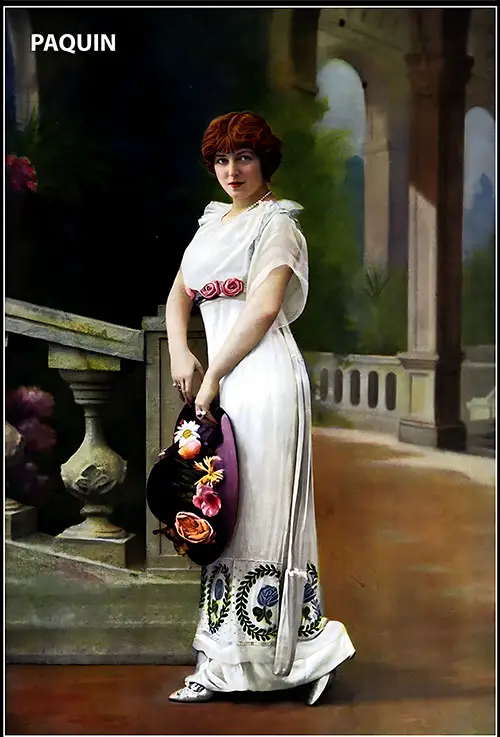
A Young Woman, Dressed by Paquin in a Stunning White Gown With Embroidered Accents, Holds a Mulberry-Colored Hat Adorned With Flowers. A Floral-Embellished Belt Is Worn Above the Waistline. (Les Modes, January 1912) | GGA Image ID # 224e7e034a
The Latest News From Paris: Paquin (1912)
This was part of a little informal but delightfully instructive chat that I had the other morning at the fascinating house of Paquin. As I listened, I also looked at ravishing frocks, frills, and filmy fabrics, all being prepared for la belle Parisienne to wear at the Riviera. I always feel like an insignificant interrogation point when I step into the artistic house of Paquin.
Many of the Paquin evening gowns are distinctively Asian in their effect. Madame Paquin especially favors the longer skirt and the skirt with the odd-looking tail train. One of her evening dresses, which shows this tail or side train, is made of canary-yellow satin. It is slashed in front, a unique feature that adds a touch of intrigue.
This gown has the bias waistline that Madame Paquin invented. A dark character note is introduced in the costume by a soft revers of black satin, which falls over the otherwise severe décolletage. In contrast, two huge roses in smoke-gray velvet, shading to black, are caught on the skirt near the point where it is slashed.

Five Gowns and Tunics Designed by Paquin. For Many Years, Madame Paquin Has Maintained an Enviable Reputation Among Couturières in Paris. While She May Not Be as Daring as Some of Her Peers, She Has Consistently Been a Leader in Introducing New Styles, Favoring the Elegant Fashions of Louis Xv and the Second Empire Over Those Influenced by the Orient. Photographs by Talbot, Paris. (Harper's Bazar, January 1914) | GGA Image ID # 224ee1e099
Captions for Five Gowns and Tunics Designed by Paquin.
In the Top Left, Paquin Designed a Black Satin Gown With a Lace Tunic Specially for Madame de Cisneros to Wear in New York.
Moving to the Top Right, We See a Frock Made of Taffeta, Her Preferred Fabric, Combined With Tulle Worn by Madame Gasc.
In the Middle, Mlle. Le Priel Showcases One of Paqpaquin’sst Elaborate Evening Gowns. It Features a White Velvet Fourreau Draped With a Lace-Tinted Tunic, Appearing Vintage and Adorned With Long Tassels Made of Seed Pearls. an Ornament of Pearls Adds a Striking Detail to the Front of the Corsage. the Angel Sleeves Are a Particular Favorite of Paquin, and This Latest Design, While Interesting, May Not Be Entirely Practical.
At the Bottom Left, We See the Tunic, Reminiscent of the Pannier Style, Which Paquin Favors. She Has Adapted an Old Gold Satin Dress Into a Royal Blue Mousseline de Soie Version. the Modestly Cut Low Corsage Features Lavish Pearl Garnitures, Though the Sleeves Have Been Entirely Omitted. the Gourah Coiffure Ornament Is a Unique Creation of Paquin.
Finally, in the Bottom Right, We Have Paquin’s Interpretation of the Black Evening Gown, Which Is Experiencing a Revival in Paris This Winter. It Is Designed for Wearability, With Soft Tulle Draping That Creates a Pannier Effect at the Sides and Sparkling Paillette Embroidery Embellishing the Skirt and Corsage.
The Tyrants of the Rue de la Paix: Paquin (1906)
Under the régime of the old masters of fashion, the head of the establishment was a sacred personality — a being to be spoken of in hushed tones and approached with tremulous awe. He hedged himself about with mystery. He represented creative intellect at its highest, and when the intellect settled down to its sacred function, nothing short of battle, murder, or sudden death would present a satisfactory excuse for an intrusion upon the privacy of the Master.
Only a few privileged ones, elect because of the size of their bills, their superlative appreciation of authentic art, or the worthiness of their faces and figures, were admitted to the Presence. They accepted the honor in a spirit of true humility. If an ordinary mortal daring as Icarus asked to see Monsieur himself, Monsieur's representatives were tolerant but pitiful. See Him! Impossible! So might the priests of old have regarded a Cook's tourist, asking to be personally conducted through the Eleusinian Mysteries.
Paquin and his followers have completely altered this. Ordering gowns is no longer a daunting task. It has become a comforting, delightful experience. While the religious fervor may have diminished, the sense of self-satisfaction has increased.
Paquin was the first, as he is the best known, of the new school. Thirteen or fourteen years ago, he was a clerk at the Bourse, with no more costuming knowledge than was to be gained by appreciative observation of les belles Parisiennes. Madame Paquin, who was not yet Madame Paquin, had a little dressmaking shop in an insignificant quarter. The two met and married. A rich patron opportunely furnished capital for an ambitious dressmaking enterprise.
The young couple opened a shop on the Rue de la Paix. There were no fanfares or drumbeats. Yet, with the opening of that little shop, Paris was set on the path to another revolution, largely due to Paquin's influence.
Today, Paquin stands at the head of the great dressmakers of Paris. His word is practically law. "Paquinesque" is the word coined to express all that is most chic.
"An ugly costume," says the first Parisienne.
"But no, ma chère, it is of Paquin,” protests the second.
"Oh, vraiment? But yes, I see. It has fine points. Ah, mon Dieu, yes, it is charming," gushes the first critic. So much for being the king who can do no wrong.
The success was, first and foremost, a success of personality.
Monsieur Paquin is a handsome man. His manner is a thing to conjure with — and he has worked it to its conjuring limit. Madame Paquin is pretty, gifted, and charming. Everyone is fond of Madame. This clever and ornamental young couple followed a new system from the first—no haughty seclusion, no barred doors at the Maison Paquin. Madame was probably met at the door by Monsieur Paquin himself, and to be met by Paquin was a treat.
The most beautiful Parisian élégantes and the homeliest old dowager received the same flattering welcome and tender interest. There was no servility in the manner. It was merely the perfection of courtesy. The customer was enveloped in a soothing, delicious atmosphere, promising deep self-esteem.
Madame Paquin continued the treatment. The charming woman and the handsome man were so deeply interested, deferential, and intelligent! This was a new experience. The Parisienne smiled, purred, under the stroking, bought more than she had intended — and came again.
Vanity is a lever stronger than awe. Paquin and his pretty wife understood that fact and built upon it. Feminine Paris chanted, "The King is dead; long live the King!" The revolution was accomplished.
Bibliography
Sloane Gordon, "The Czarina of Dress," in Cosmopolitan Magazine, New York: International Magazine Company, Vol. L. No. 4, March 1911: 451-452.
Paul H. Nystrom, PhD, "Chapter XI: The Paris Creators of Apparel Style - Paquin," in Economics of Fashion, New York: The Ronald Press Company, 1928, pp. 208-209
"In the Path of the Purchaser, Shopping for Women's Fine Fashions in 1912: Paquin, Ltd. Women's Fashions – Parisian Modistes," Cunard Daily Bulletin: The Leading and Most Influential Atlantic Ocean Daily Newspaper, Liverpool: The Cunard Steam Ship Co. Ltd., Summer Number, 1912, p. 78-89.
Pritchard, Mrs. Eric, “London & Paris Fashions: Paquin," in The Lady’s Realm: An Illustrated Monthly Magazine, London: Hutchinson and Company, Vol. XX, No. 2, June 1906, p. 229-239.
Eleanor Hoyt Brainerd, "Chapter II: The Tyrants of the Rue de la Paix: Paquin," In Vanity Fair: A Tale of Frocks and Femininity, New York: Moffat, Yard & Company, 1906, pp. 36-38.
🛳️ Ocean Travel Relevance: Couture for the Cosmopolitan Woman
During the Golden Age of Ocean Travel (1890s–1920s), women boarding luxury liners like those of the Cunard or White Star Line needed full wardrobes—daywear, walking suits, dinner gowns, and millinery—for life at sea.
🔹 Paquin’s traveling clientele, from American heiresses to European performers like Gaby Deslys, relied on her for trousseaux, cruise wardrobes, and theatre wraps featured in salons across Paris, London, and Buenos Aires.
🔹 The 1912 Cunard Daily Bulletin featured Paquin among the elite fashion houses inviting American and Colonial visitors to view their lines—cementing her transatlantic significance.
🔹 Fur-trimmed suits, light taffeta gowns, jersey walking dresses, and luxurious evening wear reflect the types of garments found in steamer trunks and documented in shipboard fashion photography.
✨ Most Engaging and Educational Highlights
💃 The Daily Dress Reviews
Madame Paquin revolutionized fashion retail with in-house fashion shows, dubbed “daily dress reviews,” well before runway fashion became standard. These were crucial to modern marketing and are ideal for discussing consumer culture and gender roles.
🎭 Fashion for Stars and Society
Gaby Deslys’s 75 gowns (Image ID #224dcfa574) showcased during The Belle of Bond Street marked theatrical glamour and costume design's link with couture.
Geraldine Farrar’s striped taffeta summer frock and Marguerite Labady’s afternoon dress show how famous women helped democratize Parisian fashion across continents.
🪡 Design Innovations
Paquin popularized:
🔹 The bias-cut waistline
🔹 Use of tulle over silver tissue
🔹 Steel lace and velvet combinations
🔹 Subtle elements like pannier-inspired tunics, angel sleeves, and asymmetrical draping
Her simplicity with elegance stood apart from her more flamboyant peers, making her designs both wearable and timeless—ideal for everyday and formal moments on land or sea.
🖼️ Noteworthy Images
“Mme. Paquin Is a Brilliant Figure in the Woman’s Movement of 1913” (Image ID #1cb58c2388)
A rare portrait emphasizing Paquin’s dual role as a fashion mogul and symbol of female enterprise. Excellent for women’s history studies.
“Evening Gown of Black Tulle and Chantilly Lace” (Image ID #1cd5a133d4)
Highlights texture, movement, and design layering—ideal for exploring textile history.
“New Street Costumes” (Image ID #1cbb1967bf)
Illustrates early 20th-century city and travel fashion—short jackets, waistcoats, velvet skirts, and fur trims meant for public display in urban and maritime environments.
“Headdress and Embroidered Dress Ensemble” (Image ID #1cbadf7a2f)
Perfect for exploring accessory design and symbolism in Edwardian fashion.
📘 Brief Dictionary of Terms for the Casual Reader
Fourreau: A slim-fitting sheath-style dress.
Godet Pleats: Triangular pleats that add fullness and flare at the hem.
Guimpe: A high-necked under-blouse, often worn under a lower-cut dress.
Mousseline de Soie: A lightweight silk fabric, similar to chiffon.
Panier: Side hoops used historically to create width in skirts—revived in 1910s-inspired silhouettes.
Passementerie: Ornamental braid or trim used in garment decoration.
Plastron: A decorative front panel on a blouse or dress.
Revers: The turned-back collar or lapel of a jacket.
Tunic: An overskirt or overlay often styled over a dress or gown.
🎓 Educational Guidance for Students & Researchers
💡 Students: This article is ideal for research on:
- Early 20th-century fashion entrepreneurship
- Gender roles in design and business
- The history of transatlantic travel culture
- Art influences in clothing (e.g., Ballets Russes)
📚 Teachers and Historians: Paquin is a bridge between Victorian tailoring and modern simplicity, and her business strategies offer parallels to today’s branding and design thinking.
🧳 Genealogists: Paquin’s garments were widely worn by women who appear on passenger lists, in portraits, or in estate inventories. Clothing descriptions in family letters may include “Paquin-style” as a mark of quality.
🔍 Reminder: The GG Archives is not a blog—use these digitized primary sources in essays, reports, or multimedia presentations. They’re authentic, searchable, and packed with visuals and references.
